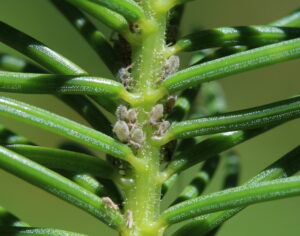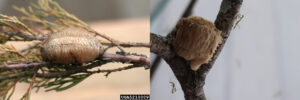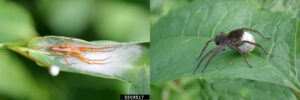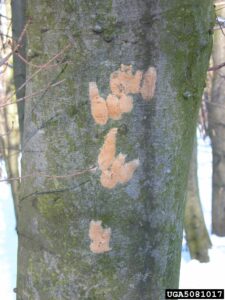Key Information:
- Insects rarely get transported inside on decorations.
- DO NOT treat your decorations with insecticide. This is potentially dangerous to your family and pets.
- Don’t worry. Most of the insects that hitch a ride on decorations are harmless.
A surprise, six-legged guest is the last thing most people want to deal with during the holidays. Though this is very rare, a few people find themselves in just such a predicament each year. Don’t worry. Most of these bugs are harmless. They’re just confused. Insects sometimes get brought inside on holiday decorations. The warm temperatures indoors trick the insects on this list into behaving like it’s spring. They emerge thinking the world around them is coming to life, only to find a strange place with no food or water for them. Most of these insects are not harmful and will likely die in a few days.
What to do
The three best ways to deal with insect or spider stowaways are:
- Check your decorations before you bring them inside. Look at the trunk and branches for any signs of eggs. If you find any, scrape them off and put them in soapy water to kill them.
- If they make it inside, use your preferred bug-catching method. This includes: carefully catching in a jar, vacuuming, and gently tossing outside.
- If you’re not sure what kind of bug it is, take a photo and report it! Invasive species sometimes hitch a ride on plant material and we want to know about it as soon as possible so we can stop them from spreading further.
The Most Common Stowaways
Insects not to worry about….
- Praying mantises
Praying mantises occasionally lay their eggs on plants used for holiday decorations. Depending on the species of mantis, eggs either form a round ball a little smaller than a ping-pong ball or lie flat on the branch (image 1). In all cases, the egg mass has a slightly foamy texture. If you find the eggs before bringing the decorations inside, clip off the branch and place it in your garden. The mantises will hatch in the spring and provide some extra pest control to your plants. If the eggs hatch inside, you may notice a large number of tiny, delicate mantises spread out around your tree. The mantises are unlikely to survive long due to the dry climate indoors and the lack of food. They can either be vacuumed up or caught in jars.
- Image 1: Mantis eggs can be oblong or round like a ping pong ball. Regardless of their shape, they are pale brown and have a Styrofoam texture. Newly hatched mantises look like a more delicate version of their adult form. Photo credits: Whitney Cranshaw; Elizabeth Barnes, Purdue University.
- Image 2: Spiders and their eggs come in many shapes. Two that you may encounter are eggs that have been attached to a curled leaf with silk and a round ball either carried by a mother spider or attached to a leaf. Photo credits: Whitney Cranshaw; Bart Everson.
- Spiders
No, spiders aren’t insects, but they are another common stowaway on holiday decorations. Spiders may shelter for the winter as adults or eggs inside plants that are common holiday decorations (image 2). They can be carefully caught in a jar and tossed outside.

Image 3: Aphids sometimes hatch when brought indoors on holiday decorations like Christmas trees. They will quickly die due to lack of food and the dry air. Photo credit: S. Rae.
- Aphids
Aphids are occasionally found on holiday decorations (image 3). Many species of aphids have life cycles tied to temperature. When they are brought inside in the winter, they become confused and emerge early. They generally die quickly on their own because the decorations do not have enough sap to sustain them. In addition, many aphids only eat very specific types of plants and are therefore unlikely to cause problems for most house plants.
Insects to worry about….
- LD Moth (Formerly gypsy moth)
LD moths (formerly known as gypsy moths) are an invasive caterpillar that can cause serious damage to oak and evergreen trees. These moths sometimes lay eggs (image 4) on plants that are transported for holiday decorations. The best ways to avoid bringing them indoors is by checking decorations for egg masses. Egg masses are roughly oval shaped, brown, and fuzzy. They contain 500-1,000 eggs which hatch into tiny, fuzzy caterpillars (~0.25 in long) with big heads. If you find egg masses or caterpillars, take a photo of them and send in a report. Next, carefully scrape them into a container of soapy water and leave them overnight.
- Image 4: LD moths sometimes lay their eggs on plants that are used as decorations. Check for brown, fuzzy egg masses like these and report them if you find any. Photo credit: Ferenc Lakatos
- Image 5: A. Adult spotted lanternflies sometimes hitch a ride on cut plants. Note the bright red hind wings and yellow abdomen. B. Spotted lantnernfly eggs easily blend into tree trunks. Here two adults sit next to a freshly laid egg mass. C. Newly hatched spotted lanternfly are small, black with white spots, and will hop when disturbed. Photo credit: A and B-Elizabeth Barnes, Purdue University; C-Pennsylvania State Extension.
- Spotted Lanternfly
Spotted lanternfly is a serious invasive insect recently found in Indiana. These insects are devastating to vineyards, can harm many types of plants, and are a general nuisance to everyone else. Adults (image 5A) and egg masses (image 5B) have been found hiding in potted plants and on tree trunks. Adults are shaped like a cicada and have striking red hind wings with black and white spots. Eggs are much harder to notice because they look like caked on mud or putty. If the eggs hatch, you might notice small black insects with white spots (image 5C) hopping near your decorations. If you find any of them, report them right away to help prevent them from becoming established in your area.
You can send in the report through:
- The GLEDN Phone App
- EDDMaps
- 1-866 NO EXOTIC (1-866-663-9684)
- depp@dnr.IN.gov
Cover image by Joan Vicent.



